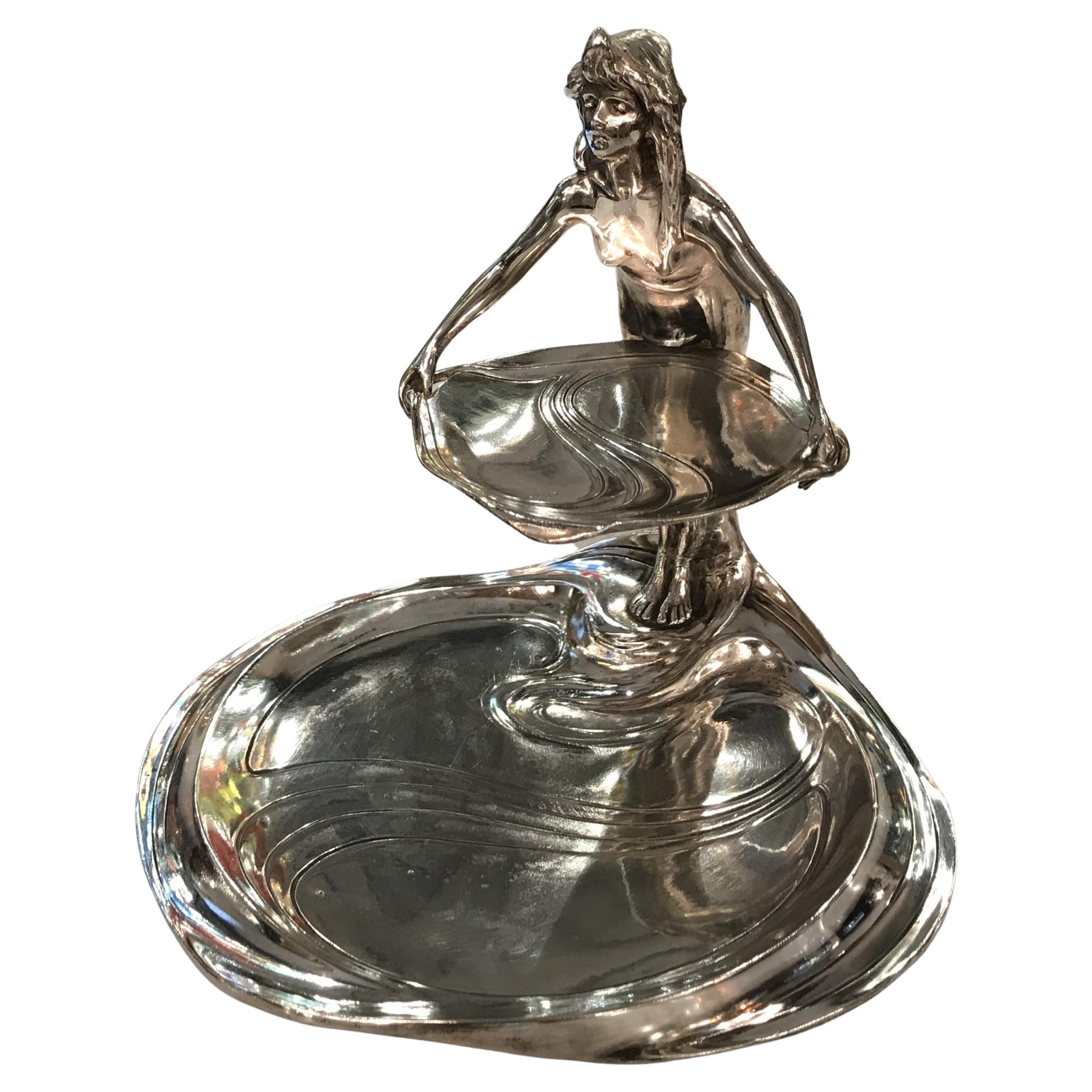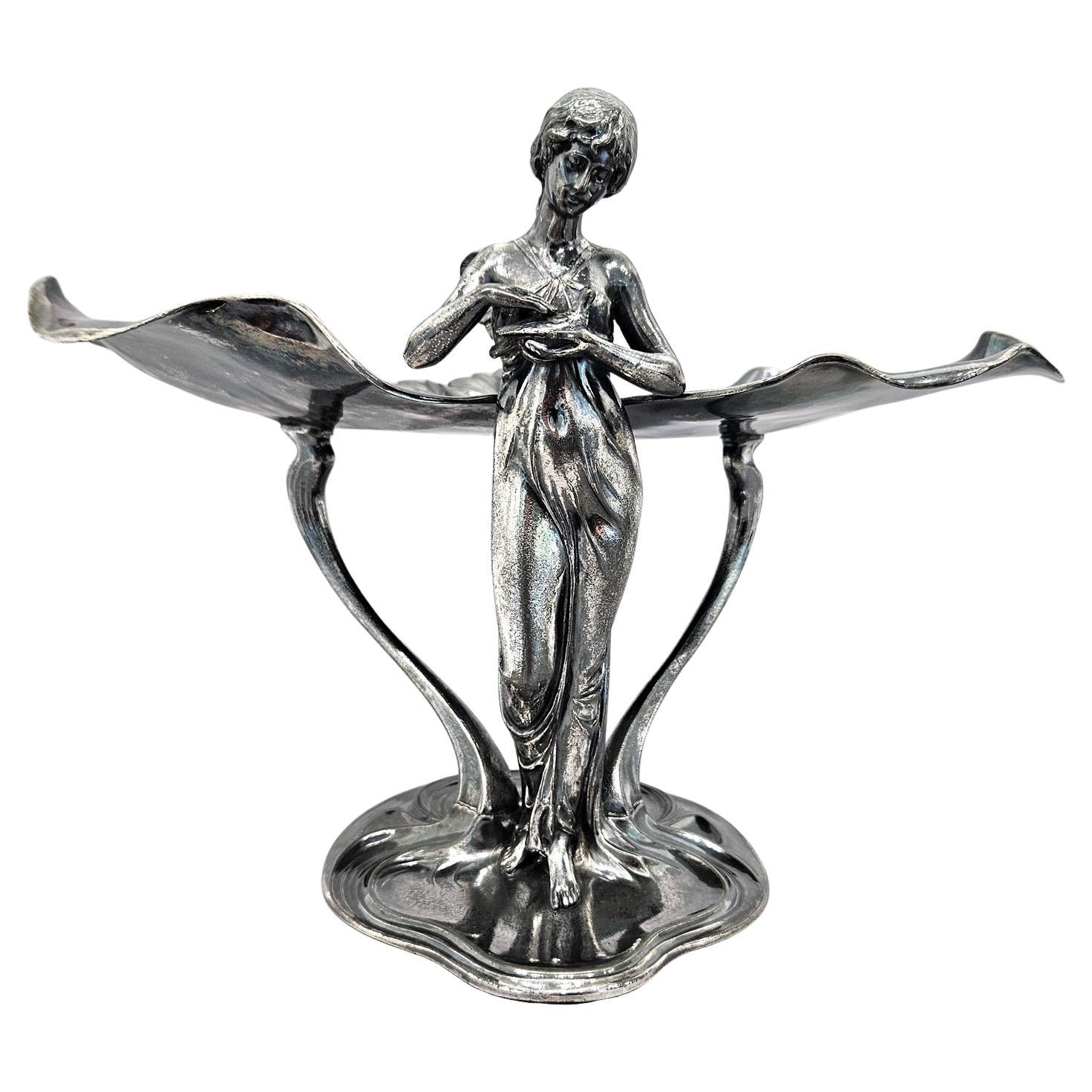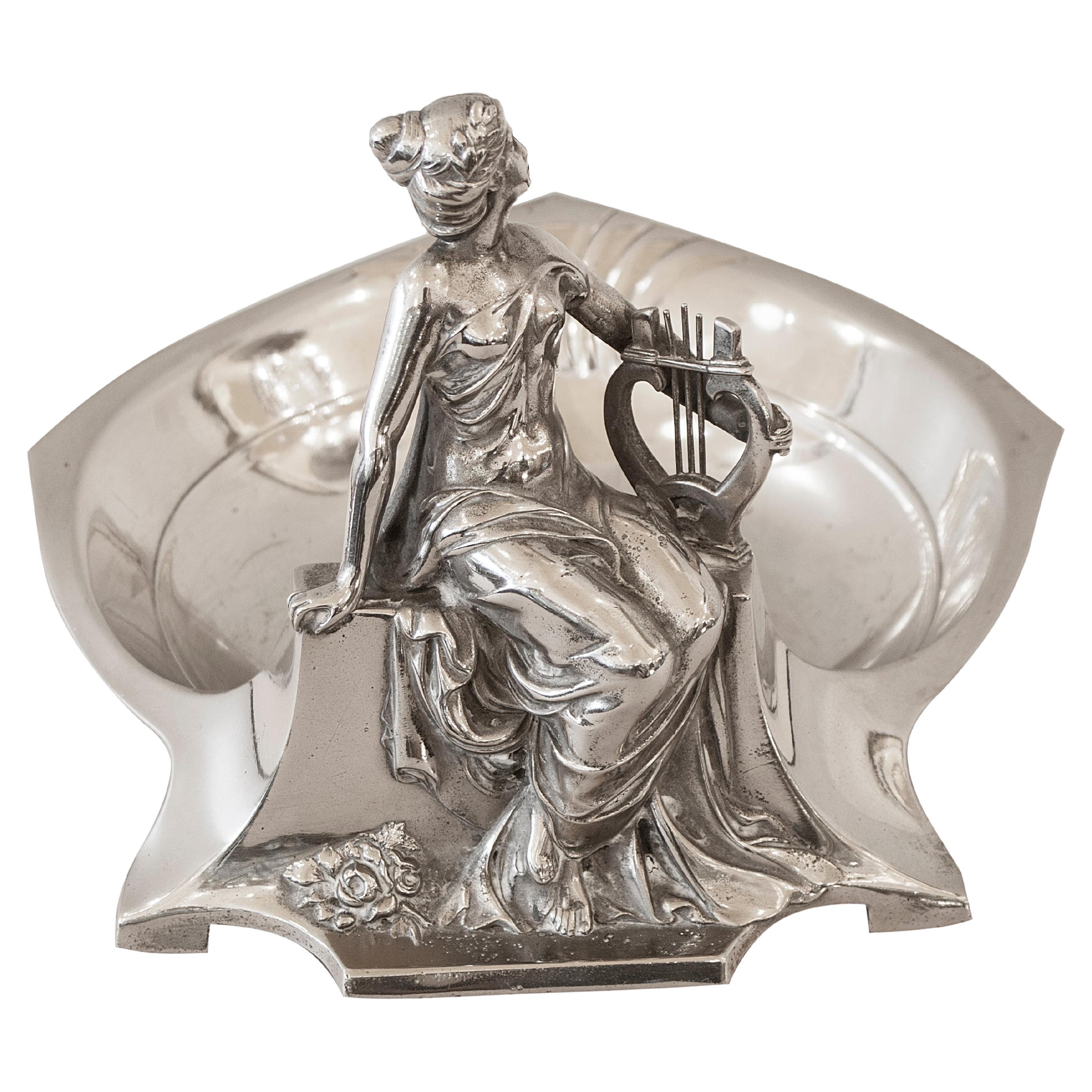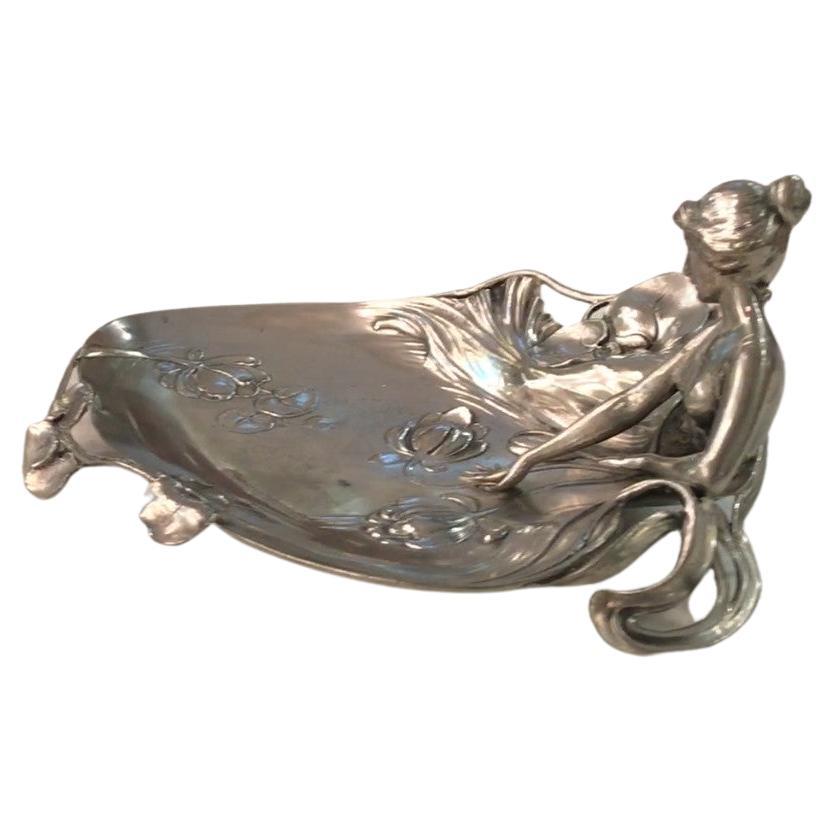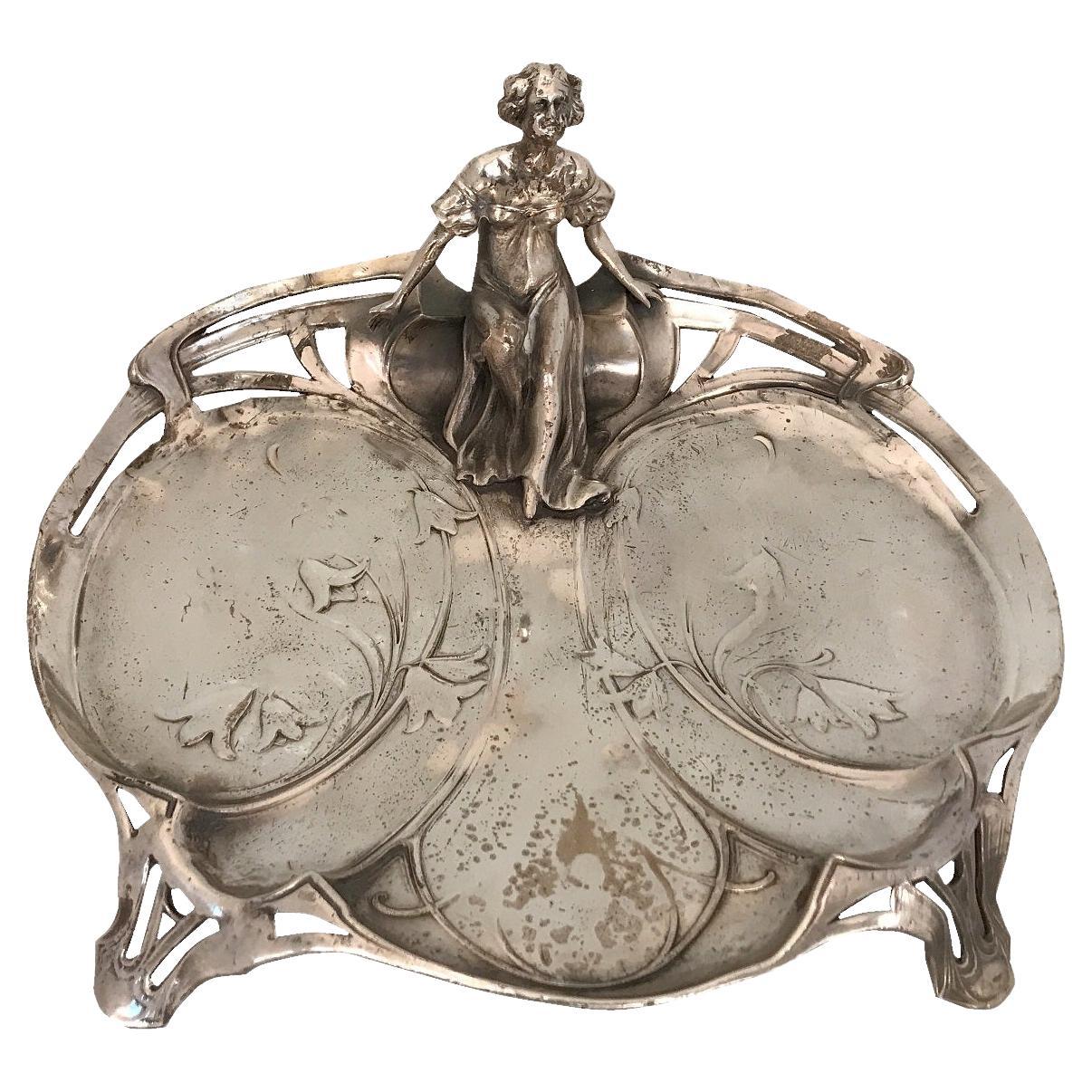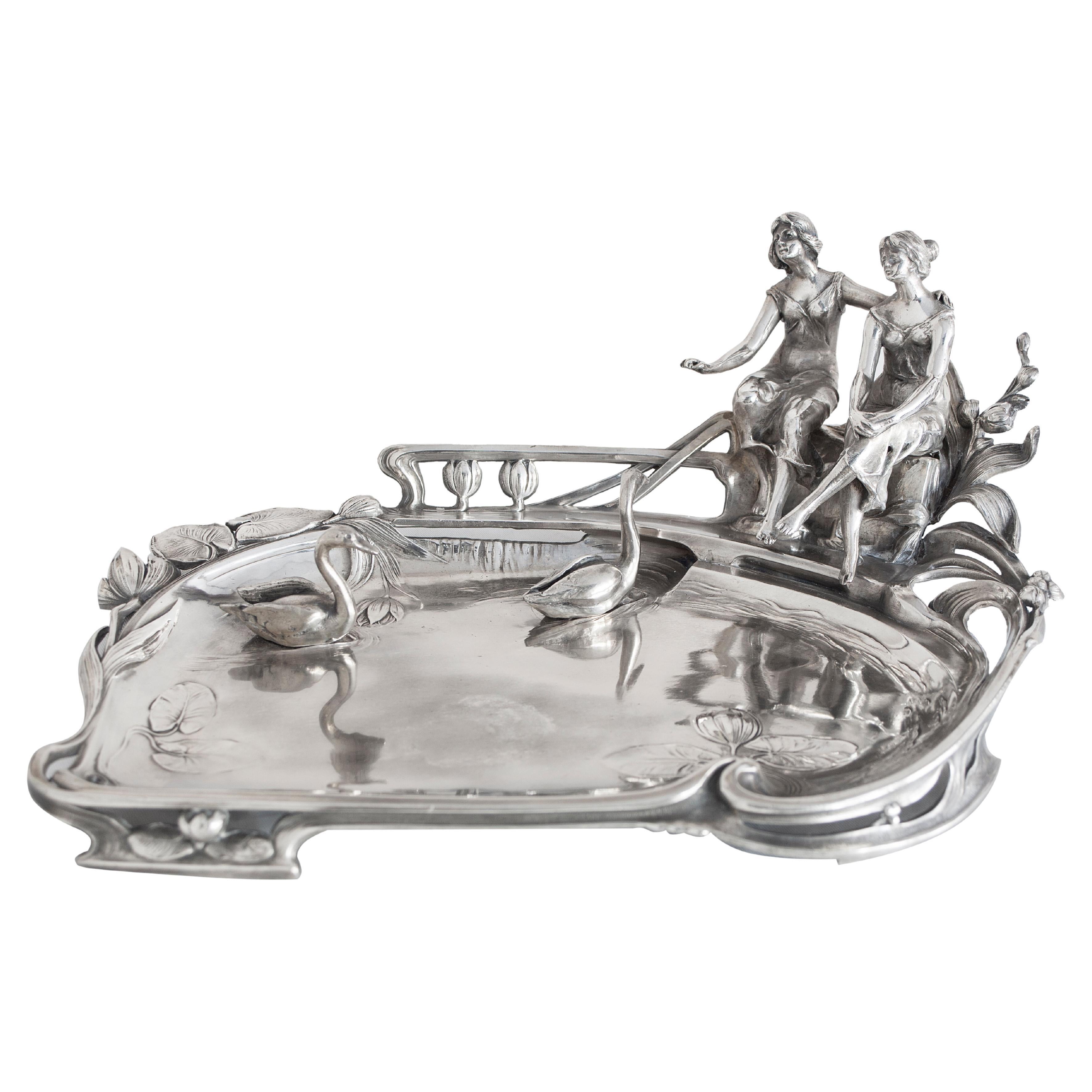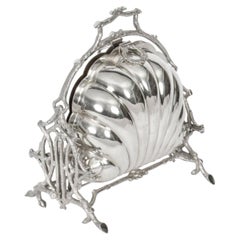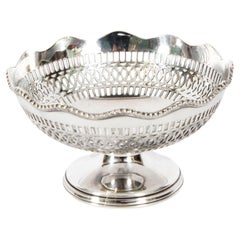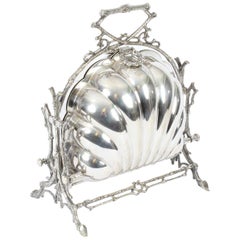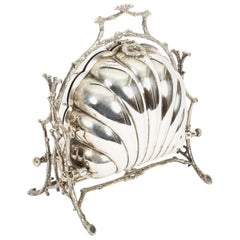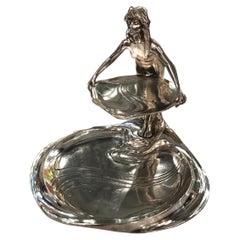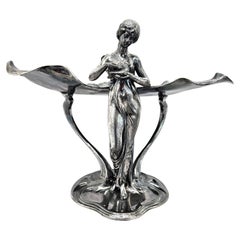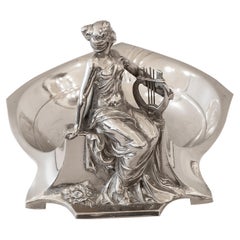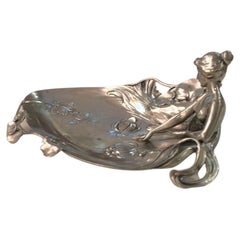Items Similar to Antique WMF Silver Plated Sweets / Visiting Card / Key/ Tray Early 20th Century
Want more images or videos?
Request additional images or videos from the seller
1 of 21
Antique WMF Silver Plated Sweets / Visiting Card / Key/ Tray Early 20th Century
$1,711.34
£1,250
€1,467.43
CA$2,400.99
A$2,638
CHF 1,360.40
MX$31,605.89
NOK 17,272.88
SEK 16,209.90
DKK 10,959.63
About the Item
This is a beautiful WMF Art Nouveau silver plated visiting card tray Circa 1900 in date.
Depicting a female figure in a long, flowing diaphanous dress, the train forming the double sided tray, with the impressed maker's mark and stamped '169' to underside.
This exquisite casket could house anything from trinkets, keys, sweets to jewellery.
Whatever you choose to use this item for you are sure to do it in style.
Condition:
In excellent condition with no dings, dents or signs of repair. Please see photos for confirmation.
Dimensions in cm:
Height 22 x Width 34.5 x Depth 16.5
Dimensions in inches:
Height 9 inches x Width 1 foot, 2 inches x Depth 6 inches
WMF
In 1853, Daniel Straub, a miller from Geislingen, joined forces with the Schweizer Brothers to form the "Metallwarenfabrik Straub & Schweizer" in Geislingen.
This was the second company to be founded by Straub - previously in 1850, from the nucleus of a small repair workshop, which he had set up to work on the construction of Geislingen's famous railway incline, he had founded Maschinenfabrik Geislingen. This company was involved mainly in manufacturing mill turbines and traded throughout Europe.
As early as 1862, the young company distinguished itself by winning a gold medal at the World Exhibition in London. In 1866, following the departure of the brothers Louis and Friedrich Schweizer, the company was renamed Straub & Sohn" (Straub & Son). The company showroom, built in 1868 in Berlin, gradually evolved to become the company's first retail outlet. Three years later, the company was already employing 60 workers. By 1880, the number of employees had grown to approximately 200 and the company was already producing 960 different items.
1880 saw the merger between Straub & Sohn and "Ritter & Co.", Esslingen, to form a public limited company under the name of Wurttembergische Metallwarenfabrik. At the time of the merger, Ritter & Co.'s Esslingen factory was already using the electroplating method of silver plating and had the more modern production facilities at its disposal. Straub's company, on the other hand, was the more profitable of the two.
1892 saw the development of a special technique for silver plating cutlery, whereby the silver is distributed in a way that, at the points of the cutlery most exposed to wear and tear, the coating is twice as thick as elsewhere. This process was patented and is still in use today. Known nowadays as 'Perfect Hard Silver plating' the technique remains exclusive to WMF.
Under Carl Hugele the company gained international standing. At the turn of the century the factory in Geislingen employed 3,000 workers. By 1910, this number had already grown to 4,000, making WMF the largest company in Wurttemberg at this time. Sales catalogues were printed in twelve languages. Subsidiary companies in London, Warsaw and Vienna opened up export markets.
Under the direction of Albert Mayer the WMF studio was influenced by the art nouveau style. The product range was modernized and considerably extended. In 1905 WMF acquired a majority holding of the Cologne company Orivit AG, which manufactured products from "Orivit", a tin alloy.
As of 1925, products created by the Contemporary Decorative Products Department (NKA) made their debut on the market. This department was set up under the direction of Hugo Debach in order to establish the name of WMF amongst consumers interested in art and design. This department was responsible for producing the special "Ikora" finish, which has earned an important place in the annals of art history. The "Ikora" brand name referred to a specific method of treating the surface of the metal, by which layers of coating were applied in a partly chemical and partly heat induced process. A host of newly developed hand-finishing techniques enhanced the possibilities for adding decorative flourishes to the products. Despite being mass produced, every item looked as if it had been individually crafted.
At the end of the war the company had lost its foreign assets, associated factories and retail outlets. The years following 1945 saw the start of a concerted effort to reconstruct in terms of personnel, organizational structures and technology in the remaining factory sites. The network of retail shops was rebuilt. Very soon, subsidiaries sprang up in the USA, Holland, Canada, Switzerland, Austria and Italy.
By 1950, WMF staff numbers had again swelled to 3,000. Silverplated tableware and cutlery accounted for two thirds of WMF's turnover, with shops specialising in clocks and watches, gold and silverware representing the company's main customers. A shift in emphasis occurred at the end of the 1950s and was marked by an increase in the importance of Cromargan cutlery and hollowware. This period saw the creation of classic products, such as designed by Wilhelm Wagenfeld, which still feature in or have been reintroduced into the WMF collection. It also saw an increase in the volume of trade in household and kitchenware items between WMF and specialist retail shops. A number of stemware collections completed the WMF catalogue, followed by the development of an extensive range of products for the hotel and catering industry.
By 1960, the Geislingen factory alone employed around 5,800 workers. A shortage of space and manpower at this site led to the setting up of additional branch factories, like the factory in Hayingen and Riedlingen.
Our reference: A3327
- Dimensions:Height: 8.67 in (22 cm)Width: 13.59 in (34.5 cm)Depth: 6.5 in (16.5 cm)
- Style:Art Nouveau (In the Style Of)
- Materials and Techniques:
- Place of Origin:
- Period:1900-1909
- Date of Manufacture:Circa 1900
- Condition:
- Seller Location:London, GB
- Reference Number:Seller: A33271stDibs: LU950634953242
About the Seller
5.0
Platinum Seller
Premium sellers with a 4.7+ rating and 24-hour response times
Established in 1983
1stDibs seller since 2012
1,410 sales on 1stDibs
Typical response time: <1 hour
Associations
LAPADA - The Association of Arts & Antiques Dealers
- ShippingRetrieving quote...Shipping from: London, United Kingdom
- Return Policy
Authenticity Guarantee
In the unlikely event there’s an issue with an item’s authenticity, contact us within 1 year for a full refund. DetailsMoney-Back Guarantee
If your item is not as described, is damaged in transit, or does not arrive, contact us within 7 days for a full refund. Details24-Hour Cancellation
You have a 24-hour grace period in which to reconsider your purchase, with no questions asked.Vetted Professional Sellers
Our world-class sellers must adhere to strict standards for service and quality, maintaining the integrity of our listings.Price-Match Guarantee
If you find that a seller listed the same item for a lower price elsewhere, we’ll match it.Trusted Global Delivery
Our best-in-class carrier network provides specialized shipping options worldwide, including custom delivery.More From This Seller
View AllAntique Victorian Silver Plated Biscuit by Box Fenton Brothers 19thC
By Fenton Brothers
Located in London, GB
This is a highly decorative antique Victorian silver plated folding biscuit box, the base bearing the makers' mark of the renowned silversmiths Fenton Brothers of Sheffield, England, circa 1890 in date and bearing the Staniforth's Patent mark as well as the registration number 3549.
It has a beautifully shaped body sitting in a cast frame with remarkably chased branch supports and the original interior features elegant hand-pierced dividers.
It opens out into two halves and is held shut by gorgeous laurel wreath loose ring handles at the top.
This wonderful container could house anything from sweets to biscuits or trinkets.
Whatever you choose to store in this lovely item you are sure to do it in style.
Condition:
In excellent condition, please see photos for confirmation.
Dimensions in cm:
Height 25 x width 19 x depth 15
Dimensions in inches:
Height 10 inches x width 7 inches x depth 6 inches
Fenton Brothers Ltd
Sheffield
Firm established in 1875 at South Moor Works, East Street, Sheffield by John Frederick Fenton...
Category
Antique 1890s English Victorian Sheffield and Silverplate
Materials
Silver Plate
Antique Victorian Silver Plated Bon Bon Dish Elkington & Co C1871 19th Century
Located in London, GB
This is a wonderful antique Victorian silver-plated bon-bon dish bearing makers marks for the renowned silvermiths Elkington & Co and dated 1871.
The dish features beaded rim with l...
Category
Antique 1870s English Victorian Sheffield and Silverplate
Materials
Silver
Victorian Silver Plated Folding Biscuit Box by Elkington, 19th Century
By Elkington & Co.
Located in London, GB
This is a beautiful antique Victorian silver plated folding biscuit box, the base bearing the makers mark of the renowned retailer and silversmith Elkington & Co of Birmingham, datin...
Category
Antique 1880s English Victorian Sheffield and Silverplate
Materials
Silver Plate
Antique Victorian Silver Plated Biscuit Box Fenton Brothers, 19th Century
By Fenton Brothers
Located in London, GB
This is a highly decorative antique Victorian silver plated folding biscuit box, the base bearing the makers' mark of the renowned silversmiths Fenton Brothers of Sheffield, England, circa 1890 in date and bearing the Staniforth's Patent mark as well as the registration number 4467.
It has a beautifully shaped body sitting in a cast frame with remarkably chased branch supports and the original interior features elegant hand-pierced dividers.
It opens out into two halves and is held shut by gorgeous laurel wreath loose ring handles at the top.
This wonderful container could house anything from sweets to biscuits or trinkets.
Whatever you choose to store in this lovely item you are sure to do it in style.
Condition:
In excellent condition. As an antique item, the piece shows signs of use commensurate with age, these minor condition issues are mentioned for accuracy and, as seen in the accompanying photographs, the biscuit box displays beautifully, please see photos for confirmation.
Dimensions in cm:
Height 25 x width 23 x depth 14
Dimensions in inches:
Height 9.8 x width 9.1 x depth 5.5
Fenton Brothers LTD, Sheffield
Firm established in 1875 at South Moor Works, East Street, Sheffield by John Frederick Fenton...
Category
Antique 1890s English Victorian Sheffield and Silverplate
Materials
Silver Plate
Antique Silver Plated and Engraved Glass Comport Centrepiece, 19th Century
Located in London, GB
This is a fabulous antique English silver-plated and engraved glass table centre comport, dated with the registration lozenge for 10th September 1...
Category
Antique 1850s English Sheffield and Silverplate
Materials
Silver Plate
Antique Victorian Silverplate Centrepiece James Deakin 19th Century
By James Deakin & Sons
Located in London, GB
This is a fine quality antique silver-plated Victorian centrepiece bearing the makers stamp to the underside of the renowned silversmiths James Deakin & Son, of Sheffield, London, Birmingham & Chester, Circa 1890 in date.
This wonderful centerpiece was made with a central vase for flowers and a dishe either side, each can be removed when required, to house sweetsd, fruit, nuts, etc
A lot of intricate detailing has gone into the creation of this beautiful item. This is an extremely well designed and attractive piece that can only grow in value.
Condition:
In excellent condition with clear makers marks and no dings, dents or signs of repair. Please see photos for confirmation.
Dimensions in cm:
Height 57 x Width 52 x Depth 26
Dimensions in inches:
Height 1 foot, 10 inches x Width 1 foot, 8 inches x Depth 10 inches
James Deakin & Sons
The firm was founded in Sheffield by James Deakin in 1866.
The first mark was entered by the firm in Sheffield Assay Office on 31 January 1878. It was a "JD" over "WD" and, possibly, represented the partnership of James Deakin and his son William Pitchford Deakin. The firm was active at Sidney Works, Matilda Street, Sheffield.
In 1886 two further sons entered in the partnership, John Deakin and Albert Deakin, and the firm was then known as James Deakin & Sons.
Further marks were entered in London Assay Office (1888) by William and John Deakin (subsidiary offices and showrooms at 48 Holborn Viaduct, London), Chester and Birmingham. Further offices and showrooms were opened at Gardiner House, 14 Charterhouse Street, London, 34 St. Enoch Square, Glasgow and 7 Queen Street, Belfast.
After the retirement of James Deakin (1893) the business was continued by his sons William, John and Albert.
In 1897 the firm was converted into a limited liability company under the style James Deakin & Sons Ltd.
The firm was the proprietor of Shaw and Fisher...
Category
Antique 1890s English Victorian Sheffield and Silverplate
Materials
Silver Plate
You May Also Like
Visiting card Tray, German, Jugendstil, Art Nouveau, Liberty, 1900, WMF
By WMF Württembergische Metallwarenfabrik
Located in Ciudad Autónoma Buenos Aires, C
Visiting card Tray, WMF, German
WMF (Wurttembergische Metallwarenfabrik)
Electro- Wurtemberg Plate Company in Geislingen, Germany, internation...
Category
Antique Early 1900s German Art Nouveau Centerpieces
Materials
Metal
WMF Art Nouveau Jugendstil Silver Plate Centerpiece Card Tray, Germany, c. 1910
By WMF Württembergische Metallwarenfabrik, Albert Mayer
Located in London, GB
A beautiful art nouveau Jugendstil silver plate centerpiece card tray or tazza of a nymph holding a dove, made by WMF in Germany c. 1910.
This is one of the most iconic pieces of ...
Category
Vintage 1910s German Art Nouveau Centerpieces
Materials
Silver Plate
Visiting Card Tray, German, Jugendstil, Art Nouveau, Liberty, 1900, WMF
By WMF Württembergische Metallwarenfabrik
Located in Ciudad Autónoma Buenos Aires, C
Double fruit or Sweet dish, Centerplace, WMF, German
Page 173: in the Book – Art Nouveau Domestic Metalwork from WMF Wurttembergische Metallwarenfabrik: The English Catalogue 1906 H...
Category
Antique Early 1900s German Art Nouveau Centerpieces
Materials
Metal
Visiting Card Tray, German, Jugendstil, Art Nouveau, Liberty, 1900, WMF
By WMF Württembergische Metallwarenfabrik
Located in Ciudad Autónoma Buenos Aires, C
Visiting card Tray, WMF, German
Page: 167 in the Book – Art Nouveau Domestic Metalwork from WMF Wurttembergische Metallwarenfabrik: The English Cat...
Category
Antique Early 1900s German Art Nouveau Centerpieces
Materials
Metal
Visiting Card Tray, German, Jugendstil, Art Nouveau, Liberty, 1900
By WMF Württembergische Metallwarenfabrik
Located in Ciudad Autónoma Buenos Aires, C
Visiting card tray, WMF, German
WMF (Wurttembergische Metallwarenfabrik)
Electro- Wurtemberg Plate Company in Geislingen, Germany, internation...
Category
Antique Early 1900s German Art Nouveau Centerpieces
Materials
Metal
Visiting card Tray, German, Jugendstil, Art Nouveau, Liberty, 1911, WMF
By WMF Württembergische Metallwarenfabrik
Located in Ciudad Autónoma Buenos Aires, C
Visiting card Tray, WMF, German
WMF (Wurttembergische Metallwarenfabrik)
Electro- Wurtemberg Plate Company in Geislingen, Germany, internation...
Category
Vintage 1910s German Art Nouveau Centerpieces
Materials
Metal
More Ways To Browse
Antique Silver Key
Key Tray
Silver Card Tray
German Plated Tray
Wmf Silver Plated Tray
Albert Mayer Wmf
Antique Meriden Silver Plate
Silver Meat Dome
Vintage Reed And Barton Silverplate
Antique Decanter Bottle Stopper
Antique Fenton Glass
Christofle Tray
Epns Silver Antique
Sheffield Gallery Tray
Sheffield Knives
Sheffield Plate Biscuit Boxes
Sheffield Silver On Copper
Silver Plate Meat Dome
